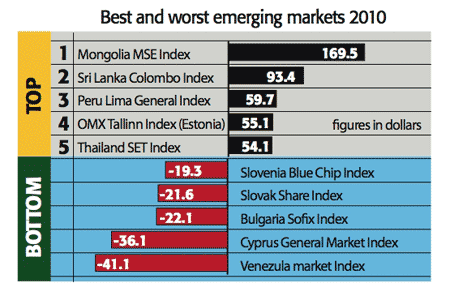
After gaining more than 80% in dollar terms last year, emerging markets kept climbing in 2010. The MSCI Emerging Markets Index rose by another 12.3% in dollars and is now around 140% up from its 2008 low. The MSCI Asia and Latin America indices gained a respective 14% and 7% this year. Indeed the top five global markets this year were all developing-market indices.
Going where the growth is
The developed world is struggling with a hangover from the credit bubble, while emerging market fundamentals remain appealing. With lower overall debt loads, plenty of raw materials and sound demographics, they are expanding faster and boast better long-term growth prospects.
So investors are “going where the growth is”, says Michael O’Rourke of BTIG. Emerging market funds have seen inflows of more than $84bn this year, eclipsing last year’s record. That’s according to EPFR Global, which monitors worldwide fund flows. It’s partly down to all the liquidity in the global system as Western central banks have kept interest rates historically low and printed money. The Fed’s latest batch of printed dollars, or QE2, “is sailing full steam ahead” into emerging markets, says Fool.co.uk ‘s Harvey Jones.
Asia, Peru and Estonia on top
As interest in mainstream emerging markets has taken off, many investors have turned their attention to hitherto obscure economies set to benefit from commodities, improved economic management, or strong growth. Enter Mongolia, a play on both commodities and China.
In the case of Sri Lanka, the main reason for mounting enthusiasm is the scope for a strong recovery following the end of the civil war in May 2009. A government spending programme on infrastructure, a 40% increase in foreign visitors in 2010, and relaxed foreign-exchange controls all bode well. The economy is expected to grow by up to 9% this year.
Peru, meanwhile, has reaped the rewards both of increased savings funding investment and having an index heavily skewed towards raw materials. In Thailand, investors have looked beyond the ongoing political stalemate and concentrated on a buoyant economy. Thai earnings have been revised upwards of late, notes JP Morgan Asset Management. Meanwhile Estonia is a bright spot in Eastern Europe. It has come through a tough fiscal squeeze and the economy is recovering. Investors hope that its adoption of the euro in 2011 will give the entire Baltic region a fillip, says Finanz und Wirtschaft.
Eastern Europe: still struggling
Eastern Europe was hit harder by the crunch than other emerging regions, as it had gone on a credit binge on money borrowed from abroad. The region is gradually recovering, but deleveraging by households and fiscal squeezes have hampered growth. Stocks in Bulgaria and Cyprus have been undermined by the two countries’ close links to Greece. Slovakia and Slovenia are in better shape, but highly exposed to the eurozone. Recent jitters have shaken both. As for Venezuela, falling oil production, ongoing nationalisations and a recent power grab by president Hugo Chavez are the latest headaches for investors.
Eastern European markets are most in need of a “global leg-up”, as Capital Economics puts it. However, it’s worth noting that other emerging markets may boast sound fundamentals, but are also closely linked to global equities. So, as we were reminded this year, any setbacks for global sentiment will take their toll on emerging markets. Investors can flood out as fast as they flood in.